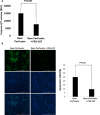A Small Animal Model of Ex Vivo Normothermic Liver Perfusion
- PMID: 30010635
- PMCID: PMC6102010
- DOI: 10.3791/57541
A Small Animal Model of Ex Vivo Normothermic Liver Perfusion
Abstract
There is a significant shortage of liver allografts available for transplantation, and in response the donor criteria have been expanded. As a result, normothermic ex vivo liver perfusion (NEVLP) has been introduced as a method to evaluate and modify organ function. NEVLP has many advantages in comparison to hypothermic and subnormothermic perfusion including reduced preservation injury, restoration of normal organ function under physiologic conditions, assessment of organ performance, and as a platform for organ repair, remodeling, and modification. Both murine and porcine NEVLP models have been described. We demonstrate a rat model of NEVLP and use this model to show one of its important applications - the use of a therapeutic molecule added to liver perfusate. Catalase is an endogenous reactive oxygen species (ROS) scavenger and has been demonstrated to decrease ischemia-reperfusion in the eye, brain, and lung. Pegylation has been shown to target catalase to the endothelium. Here, we added pegylated-catalase (PEG-CAT) to the base perfusate and demonstrated its ability to mitigate liver preservation injury. An advantage of our rodent NEVLP model is that it is inexpensive in comparison to larger animal models. A limitation of this study is that it does not currently include post-perfusion liver transplantation. Therefore, prediction of the function of the organ post-transplantation cannot be made with certainty. However, the rat liver transplant model is well established and certainly could be used in conjunction with this model. In conclusion, we have demonstrated an inexpensive, simple, easily replicable NEVLP model using rats. Applications of this model can include testing novel perfusates and perfusate additives, testing software designed for organ evaluation, and experiments designed to repair organs.
References
-
- Network OPaT. National Data. Overall by Organ. Current U.S. Waiting List. Based on OPTN data as of October 19, 2017. 2017. Available from: https://optn.transplant.hrsa.gov/data/view-data-reports/national-data/#.
-
- OPTN OPaTN. National Data, Transplants by Donor Type, U.S. Transplants Performed January 1, 1988 - December 31, 2016, For Organ = Liver. 2017. Available from: https://optn.transplant.hrsa.gov/data/view-data-reports/national-data/#.
-
- Nemes B, et al. Extended criteria donors in liver transplantation Part I: reviewing the impact of determining factors. Expert Rev Gastroenterol Hepatol. 2016;10(7):827–839. - PubMed
-
- Nemes B, et al. Extended-criteria donors in liver transplantation Part II: reviewing the impact of extended-criteria donors on the complications and outcomes of liver transplantation. Expert Rev Gastroenterol Hepatol. 2016;10(7):841–859. - PubMed
Publication types
MeSH terms
Grants and funding
LinkOut - more resources
Full Text Sources
Other Literature Sources
Medical
Research Materials
Miscellaneous
















